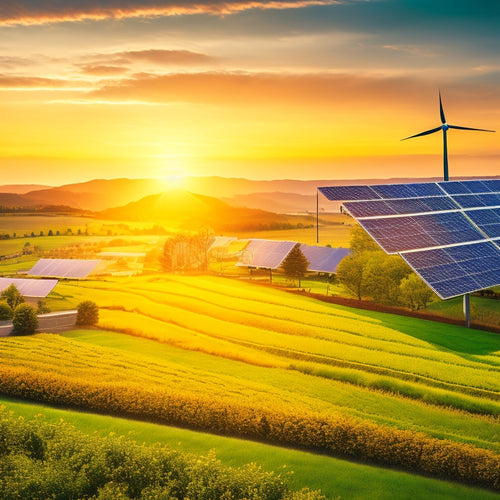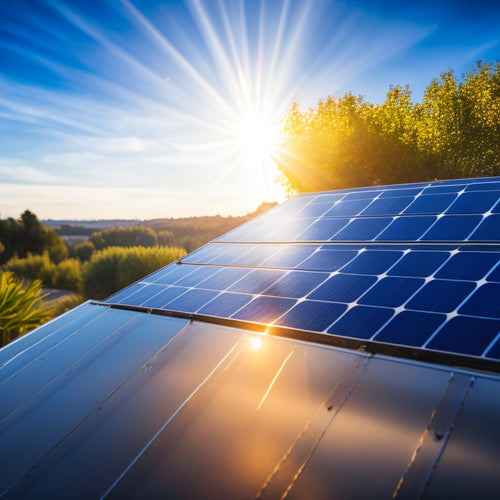
5 Best Affordable Home Energy Solutions
Share
You're taking control of your energy bills and environmental impact by exploring affordable home energy solutions. You can utilize renewable energy with affordable solar panels, which reduce your reliance on the grid and lower energy bills. Energy-efficient window solutions, like window films and thermal curtains, minimize heat loss and gain. Cost-effective insulation options, including DIY materials and radiant barriers, maintain comfort and energy efficiency. Budget-friendly smart thermostats provide precise temperature control, and efficient water heating systems, such as tankless and heat pump options, considerably reduce energy consumption. Now, uncover how these solutions can work together to optimize your home's energy performance.
Overview
- Affordable solar panels reduce energy bills and carbon footprint, with federal tax credits covering up to 26% of the total cost.
- Energy-efficient window solutions like window films, thermal curtains, and double-glazed windows minimize heat loss and gain.
- Cost-effective insulation options like DIY materials and radiant barrier insulation maintain comfort and reduce energy consumption.
- Budget-friendly smart thermostats provide precise temperature control and energy monitoring, starting at around $100.
- Efficient water heating systems like tankless and heat pump water heaters significantly reduce energy consumption and lower bills.
Affordable Solar Panels for Homes
Your energy-conscious home upgrade begins with affordable solar panels. By utilizing renewable energy, you'll reduce your reliance on the grid and lower your energy bills.
To guarantee a seamless changeover, consider the system compatibility and integration of your solar panel system, and take advantage of solar panel incentives, such as the federal solar investment tax credit, which can cover up to 26% of the total cost.
Community solar programs are another option, allowing you to purchase a share of a local solar array and receive credits on your energy bill.
With affordable solar panels, you'll enjoy energy independence and a smaller carbon footprint. Plus, many states offer additional incentives, such as net metering and rebates, to encourage the adoption of solar energy.
Energy Efficient Window Solutions
Windows are an essential aspect of your home's energy efficiency, as they can account for up to 30% of heat loss in the winter and heat gain in the summer. To combat this, you can implement energy efficient window solutions that won't break the bank.
| Solution | Benefits |
|---|---|
| Window Films | Reduces heat gain by 80%, blocks 99% of UV rays |
| Thermal Curtains | Reduces heat loss by 25%, adds insulation |
| Double-Glazed Windows | Reduces heat transfer by 50%, reduces noise pollution |
| Low-E Coatings | Reduces heat gain by 50%, reduces fading of furniture |
Cost-Effective Insulation Options
Proper insulation is an essential aspect of maintaining a comfortable and energy-efficient home. You can achieve this by using cost-effective DIY insulation materials, such as fiberglass batts, cellulose, or spray foam.
These materials can be easily installed in your attic, walls, or floors to reduce heat loss and gain. Additionally, thermal barrier techniques like radiant barrier insulation can be used to reflect heat rather than absorb it, keeping your home cooler in the summer and warmer in the winter.
Furthermore, with energy efficiency measures(https://www.illchanterlater.com), you can further reduce your energy consumption and save money on your utility bills. By considering energy storage needs and planning for system expansion, you can create a more sustainable and efficient home.
Budget-Friendly Smart Thermostats
How much control do you really have over your home's temperature? With traditional thermostats, the answer is "not much."
But budget-friendly smart thermostats can change that. These devices give you precise control over your home's temperature, allowing you to adjust it from your phone or tablet.
When it comes to energy storage systems, integration with home automation systems allows for remote energy monitoring and control. Look for thermostat features like geofencing, scheduling, and energy usage tracking to maximize your energy savings.
Many smart thermostats also integrate with popular smart home systems, allowing you to control your temperature alongside your lights, security cameras, and more.
With prices starting at around $100, smart thermostats are an affordable way to take control of your home's energy usage and enjoy the freedom of a more comfortable living space.
Efficient Water Heating Systems
About 80% of the energy used in the average American home goes towards heating water, making it a significant contributor to your energy bill.
You can break free from this energy drain by upgrading to an efficient water heating system. Consider tankless water heaters, which heat water only when needed, eliminating standby heat loss.
Alternatively, heat pump water heaters are a cost-effective option, using heat from the air to warm water.
Both options can reduce your energy consumption and lower your bills.
Frequently Asked Questions
How Do I Know if My Home Is Energy-Efficient?
You're wondering if your home is energy-efficient. Start by conducting an energy audit to identify areas for improvement, then consider insulation upgrades to reduce heat loss and gain; these steps will help you pinpoint opportunities to optimize your home's energy performance.
Can I DIY Energy-Efficient Home Improvements?
You're not a pro, but you're handy - can you really DIY energy-efficient home improvements? Yes, you can tackle insulation improvements, but solar panels may require skill; research, plan, and don't be afraid to call in the pros when needed.
Are Energy-Efficient Appliances Worth the Cost?
When you invest in energy-efficient appliances, you'll reap significant energy savings over their longer lifespan, which can offset the higher upfront cost; however, you'll need to weigh these benefits against your specific budget and energy usage to determine if they're worth the cost for you.
Do Energy-Efficient Upgrades Increase Home Value?
When you invest in energy-efficient upgrades, you're likely to enhance your home's value; in fact, a pre-sale energy audit or home inspection can increase your sale price by up to 10%, giving you more freedom to negotiate or reinvest.
How Long Does It Take to See Energy Savings Results?
As you flip the switch, a wave of efficiency washes over your home; with energy monitoring, you'll start seeing the ripple effects of savings within 3-6 months, and a tangible timeline of returns will begin to take shape, freeing you from energy waste.
Ready to Buy
As you commence on your expedition to a more energy-efficient home, remember that every small step counts. Like the ripples that spread from a single stone cast into a pond, each of these affordable solutions has the potential to create a significant impact on your energy consumption and your wallet. By incorporating these measures, you'll be well on your way to reducing your carbon footprint and saving money - a victory that's music to the ears of both your wallet and the planet.
Related Posts
-

Net Metering in Renewable Energy's Future
Net metering's future is vital for driving renewable energy growth and financial savings. You can reduce your electri...
-

What Types of Solar Energy Devices Are Available
You'll find several types of solar energy devices available today, each customized to different energy needs. Photovo...
-

How Efficient Are Thin Film Solar Cells
Thin film solar cells provide an innovative approach to energy generation, boasting efficiency rates generally betwee...


